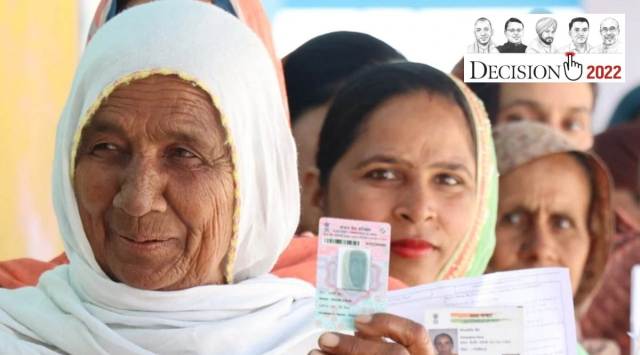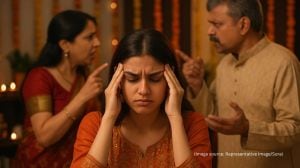Poll panel revises Punjab voter turnout to 71.95%
The revised percentage is higher than the around 66% turnout recorded till 5pm on Sunday, according to preliminary data released by the EC.
 Voters in queue at village Naruana in Bhatinda Rural. (Express Photo by Gurmeet Singh)
Voters in queue at village Naruana in Bhatinda Rural. (Express Photo by Gurmeet Singh)A day after Punjab voted in a crucial Assembly election, the Election Commission revised the polling percentage to 71.95%, still short of the 77.2% turnout recorded last time.
This is the lowest voting percentage in the last four Assembly elections. In the 2017, the voting percentage was 77.2. The percentage in 2007 and 2012 was 75.45 and 78.20, respectively. In the 2002 elections, the voting percentage was 65.14.
This time, the Malwa region of the state took the lead in high voter turnout as compared to Majha and Doaba, as per the updated EC data.
At 55.40%, Amritsar West recorded the lowest polling. The highest polling took place at Gidderbaha constituency at 84.93%.
Transport Minister Amrinder Singh Raja Warring is pitted against Hardeep Singh Dimpy Dhillon of SAD and Pritpal Sharma of AAP from this constituency. In 2017 pollls, Gidderbaha has witnessed 89.02% voting.
Talwandi Sabo constituency saw the second highest polling at 83.70% with sitting MLA Baljinder Kaur of AAP seeking re-election against Khushbaaz Singh Jattana of Congress, Jeet Mohinder Singh Sidhu of SAD and Harminder Singh Jassi, a close relative of Dera Sacha Sauda Chief, Gurmeet Ram Rahim who is standing as an Independent. In the previous polls in 2017, the same constituency had seen 86.04% polling.

Among the districts, Mansa saw the highest polling at 81.24%, followed by Muktsar at 80.49%. Lowest polling in districts was reflected in Amritsar (65.84%).
In Bhadaur and Chamkaur Sahib constituencies from where Chief Minister Charanjit Singh Channi is contesting, the voting percentage was 78.90% and 74.52%, respectively. In comparison, in 2017, Bhadaur had seen 83.12% polling and Chamkaur Sahib had recorded 77.78%.
In Dhuri, the constituency of AAP CM face Bhagwant Mann, 77.37% votes were polled compared to 81.23% in 2017.
In Doaba region, highest polling took place at Balachaur (73.77%), while the lowest was recorded in Jalandhar Central (60.65%).
In Sultanpur Lodhi, where the official Congress candidate is facing a challenge from Cabinet Minister Rana Gurjeet’s son, Rana Inder Pratap Singh, 72.55% voting was recorded as compared to 76.93% in 2017 polls.
In Majha region, highest polling at 76.33% took place in Sujanpur, the constituency considered the stronghold of the BJP.
In Amritsar East, where a keenly watched contest is taking place between Punjab Congress president Navjot Singh Sidhu and Akali leader Bikram Singh Majithia, 64.05% voting took place. In 2017, this constituency had recorded 64.94% turnout.
Overall, out of the total 2.14 crore voters in the state, 1,54,69,618 cast their votes. Out of these 81,33,930 were male, while 73,35406 were females and 282 were transgenders. In 2017 Assembly polls, 1,54,62,803 voters had cast their vote out of a total of 2,00,29,646 registered to vote.
According to the Chief Electoral Officer, S Karuna Raju, 33 FIRs were registered on polling day with ten of them related to minor clashes, 16 to violation of prohibitory orders, three related to poll offences, and three other cases and one related to firing incident.
“All 117 strong rooms at 17 locations have been sealed as per EC guidelines and three-tier security measures have been set up with deployment of central armed police forces and Punjab Police,” he said.
Also, 65 ballot units and 60 control units in addition to 738 VVPATs were replaced during the conduct of poll.






- 01
- 02
- 03
- 04
- 05

























